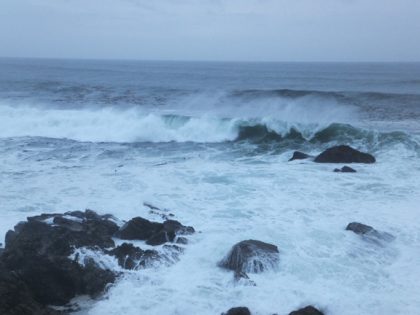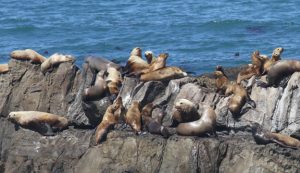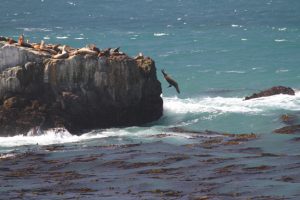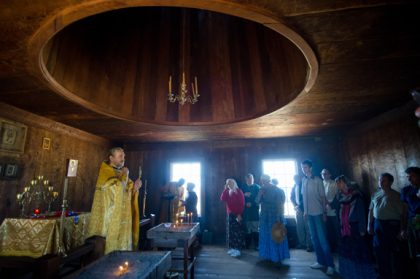JANUARY 2021 ENEWS
Dear friends of Salt Point and Fort Ross,

A big storm brought us quite a wild night here on the Sonoma coast, with several inches of rain at lower elevations and up to four inches along the ridgeline. Winds were gusting up to 70 miles an hour, many tree limbs came tumbling down and some areas lost power. The sun was out this morning, but to drive to Fort Ross today Operations Manager Sarjan needed an escort wielding a chainsaw to clear the road. We were also grateful to see Chris Heintzelman and the California Conservation Corps on the roads moving debris - thank you California State Parks! The rain is much appreciated but some days we’d prefer a long slow Seattle drizzle to this high drama coastal weather.
While we welcomed in the new year with enthusiasm, operations at Fort Ross and Salt Point remain complicated: Fort Ross State Historic Park trails, beaches, and parking lots are open to the public. The bookshop is open but the museum and auditorium are closed. The Call House museum remains closed. You can enter the historic Russian compound but the buildings inside the compound are locked due to Covid-19 safety precautions.
Reef Campground is closed for repairs -- State Parks is aiming to open it this year, hopefully by autumn.
For now, Salt Point State Park trails, parking lots, and campgrounds are closed. Please check the State Parks website for updated information.
Thankfully the landscape follows its own cycles, happily oblivious to our rules and regulations, and the marine terrace in winter looks fresh and green and full of promise. I recommend a long walk along the ocean keeping a weather eye out for budding spring wildflowers or migrating whales. Rain or shine, it always inspires.
Read on for stories and updates from the FRC team.
Sincerely,
Sarah
Sarah Sweedler
Fort Ross Conservancy CEO
Sea Lion Survey Project Annual Report
 Just as the sea lions of Fort Ross live on so does Fort Ross Conservancy’s Sea Lion Survey Project! Although we had to cancel a number of our regular, monthly surveys due to the challenges brought on by the COVID-19 pandemic and last year’s raging wildfires, our sea lion surveys are back in full swing and we even ended the year with a couple of noteworthy highlights to share with.
Just as the sea lions of Fort Ross live on so does Fort Ross Conservancy’s Sea Lion Survey Project! Although we had to cancel a number of our regular, monthly surveys due to the challenges brought on by the COVID-19 pandemic and last year’s raging wildfires, our sea lion surveys are back in full swing and we even ended the year with a couple of noteworthy highlights to share with.
The Sea Lion Survey Project is fueled by the energy of our dedicated volunteers who delight in observing the magnificent--and entertaining--Steller (Eumetopias jubatus) and California sea lions (Zalophus californianus) who make their home in the rich coastal waters of Fort Ross State Historic Park. During each monthly survey, we hike to the edge of Fort Ross’ glorious coastal bluffs and observe the sea lions that haul out and rest on the Sea Lion Rocks. We record species-specific population counts, weather and environmental conditions, noteworthy behaviors, human activities (such as fishing, kayaking, and planes overhead), human-caused disturbances to the animals, and note any lions that have a tag or brand.

In the last several years one of our major goals has been to share the data we are collecting with other agencies and organizations. We want our time and energy spent in the field to result in sharing our data with those who can use it to help answer scientific questions about these marine mammals that have been around for millions of years, and who can better protect them from significant threats to their health and environment. In 2020 we worked with one of our partners to set up a database to enter and store our survey data. This allowed us to readily share this data with the California Department of Fish & Wildlife’s California Natural Diversity Database and The Marine Mammal Center. This work is ongoing and we have some promising leads, making us quite optimistic that we will be continuing to grow our partnership circle in 2021.
.jpg) In addition to maintaining our survey project, over the last several years we have strived to raise greater awareness of the sea lions. Since they are primarily found on off-shore rocks and are roughly a 20-minute hike out from the visitor center and fort, it’s very easy for visitors to come and go without ever knowing that these animals are out here sharing their home with us. In 2020 our crew got together to film a short movie about the Sea Lion Survey Project which is available to view on our Youtube channel. We hope you’ll enjoy joining us, virtually, out on the bluffs to learn about the sea lions of Fort Ross and our field work! Please note that the movie includes locally acquired footage from longtime sea lion surveyor and wildlife photographer Jamie Hall, however the clip demonstrating sea lion disturbance is archival footage from Canva.
In addition to maintaining our survey project, over the last several years we have strived to raise greater awareness of the sea lions. Since they are primarily found on off-shore rocks and are roughly a 20-minute hike out from the visitor center and fort, it’s very easy for visitors to come and go without ever knowing that these animals are out here sharing their home with us. In 2020 our crew got together to film a short movie about the Sea Lion Survey Project which is available to view on our Youtube channel. We hope you’ll enjoy joining us, virtually, out on the bluffs to learn about the sea lions of Fort Ross and our field work! Please note that the movie includes locally acquired footage from longtime sea lion surveyor and wildlife photographer Jamie Hall, however the clip demonstrating sea lion disturbance is archival footage from Canva.
To learn more about the Sea Lion Survey Project, please visit our website and check out our previously published annual reports from 2019 and 2020. If you have any questions or are interested in accessing our 2020 survey data, feel free to email me at charonv@fortross.org. If you’d like to support Fort Ross Conservancy’s work please consider becoming a member or making a donation.
I hope this year you will have the opportunity to bundle up with a good telescope or nice pair of binoculars and enjoy observing the spectacular sea lions of Fort Ross. We might just see you out on the bluffs!
--Charon Vilnai, Programs Instructor, Sea Lion Survey Project Lead, and Call House Museum Lead
Education in the Time of Covid
The last ten months have been quite an intense ride as we live through a global pandemic. We all owe a great debt to the heroes of the day - the health care workers on the frontlines. There is another group, however, who deserve immense recognition: educators. They continue to dedicate themselves to the advancement, health, and happiness of our society through teaching. Teachers, parents - and the environmental educators - are facing the tremendous challenge of transitioning from in-person education to internet-based distance learning.
To be of service to public education, Fort Ross Conservancy’s educators (Charon Vilnai and myself) have also adapted our in-person, hands-on programs to distance learning experiences.
We are incredibly proud of what we’ve created, not only as a way to bring the outdoor experience to students during Covid, but as programs Fort Ross Conservancy are able to offer well into the future. Each unique experience is interactive, engaging, and adaptable for groups of all ages, whether for young learners or curious adults. Each experience is a deeply localized blend of cultural and natural history, weaving in critical thinking, situational observation practice and environmental literacy.
Our Environmental Living Distance Learning Experience tells stories that paint a rich picture of the remarkable history of Fort Ross. Our Marine Ecology Distance Learning Experience illustrates how connected we are to our histories, how those events and human impacts from the past directly affect the world we live in today - for example kelp loss along the Sonoma and Mendocino Coasts.
As instructors we have had the privilege to work with hundreds of teachers and parents from all over the state every year, and over the last ten months we’ve been able to stay connected with dozens of teachers as they have navigated the rocky terrain of distance education, learning from each other's mistakes and sharing ideas with each other, advancing through our collective successes.
In thinking about this article, I knew I had to share the stories I’ve been hearing directly from my community of teachers for months.
How is distance teaching working for you?
“Distance-Learning is very challenging because you can't help your students in the same way as when they are at the school/brick & mortar. It has taken many long hours to convert my entire curriculum into Google Classroom. If you are not bilingual the language barrier is more extreme. The children are lacking in social-emotional development. Parents and students are often frustrated and you have many long hours trying to alleviate the situation. Teachers are teaching social/emotional/trauma-based learning online. The students miss their friends the most and often feel isolated. Some children are not attending school because of the stress distance-learning has created for families, and the Pandemic, in general. School Districts are feeding families, too. You can't learn if you're hungry and living below the poverty line, as many families are food deprived. This is why virtual field trips are so important. The children need to learn and have contact with higher-level learners and educated people (creates hope and opportunity!). Schools are a safe place for children with rules, structure, routines, and PBIS (Positive Behavior In Schools). An education is something that no one can take away from you!!”
- Stephanie Phillips, John Reed Elementary School
What's the most challenging part of distance learning?
“There are many aspects of distance learning that are challenging, I obviously miss the personal connection with students. What has to be the most challenging though is the inequity of distance learning. So many students have limited access to the internet, even with school provided equipment. Not all students have a quiet space to work or need to watch siblings during the day. I've had students sitting in their parents car, using an old cell phone and supervising siblings trying to zoom. And some teachers demand all students have their camera on. It can be traumatic for some children.”
- Blossom Lievore, Fort Ross School
How are your kids doing with distance learning?
“Some kids are flourishing but most are struggling. The biggest obstacle I see is engagement and motivation to do work. Students don't see the loss and long-term harm "checking/dropping-out" at 12 years old will create. They are short sighted but that's only because they lack the perspective to understand the importance of education.”
- Joey Gallucci, Guerneville School
How meaningful are virtual field trips in these times?
“I've always found virtual field trips to be meaningful, specifically because we are a rural school and have limited opportunities for field trips; rural and other high poverty school students have always benefited from these opportunities. In these pandemic times virtual field trips are even more necessary, not just for content the kids will be exposed to but the opportunity to work with new people, hear about other schools, other teachers, and other opportunities. Virtual field trips give the children something to look forward to, a reminder the rest of the world is still out there and what life looks like now isn't forever.”
- Blossom Lievore, Fort Ross School
What are the biggest challenges with distance learning?
“I don't get to see my friends very much. School work is hard without easy access to the teacher's help. It's hard to stay motivated to pay attention and get my work done. I'm bored staying home all day”
- N. P. - Guerneville School
What was your overall impression of the field trip to Fort Ross?
“I thought it was pretty good. I like ocean science but I feel sad we are in remote learning. For a field trip it was 8/10, but for distance learning it was a 10/10.”
- E. M. - Guerneville School
How was your Distance Learning Experience with Fort Ross Conservancy?
“The follow up conversation I had with my students was remarkable. They told me about the Russians bringing Alaskan hunters to land already occupied by Kashia Pomo for thousands of years. They remembered details about the sea otter, a keystone species, and how its decreased population contributed to a rise in the sea urchin population and kelp die out. They reminded me what "upwelling" was. They talked about how much the decisions made by people over 200 years ago is currently affecting the health of sea life in the Fort Ross area today. They reflected on how decisions they make in their lifetimes might impact future generations. Wow! That was a lot of learning in one short hour. A virtual field trip is not the same as being there live, but it is a wonderful way to have an experience "outside" of the classroom environment during a pandemic. Thank you so much, Song Hunter, for the thoughtful, educational, and inspirational way you tackled the content with fourth graders.”
- Lamiel Bjorkquist, West Side School
“My fourth graders really enjoyed the Distance Learning Experience at Fort Ross. It was a treat to get to see the insides of the buildings and get a bigger picture of what life was like at Colony Ross back in the early 1800s. I could tell that they learned a lot by reading the first-person journal entries they wrote from their character's perspective after the field trip.”
- Julie Meierding, Live Oak Charter School
Through each distance program we lead, we are opening doors to experiences and opportunities in natural and cultural history that may influence our students’ lives forever. As an environmental educator, I truly miss exploring the coast with young people, but given that’s not possible, I am incredibly grateful for the opportunity to continue connecting people to nature and creating lasting outdoor memories. These experiences are a shining light to combat these dark times. They refuel us.
Our work is needed more than ever, connecting youth (and adults) to nature and continuing the conversation about the interconnectedness of our global environment.
--Song Hunter, Director of Programs
California’s forgotten Orthodox clergyman who lived at Fort Ross
 Nikolay Petrovich Chechenev could well be the only Russian Orthodox clergy directly associated with Fort Ross - a man who was probably involved in the construction of the trading outpost where he settled for nearly a decade. Information about Chechenev is scarce and further investigation into this man’s biography definitely warranted, but we will share what we’ve rediscovered so far.
Nikolay Petrovich Chechenev could well be the only Russian Orthodox clergy directly associated with Fort Ross - a man who was probably involved in the construction of the trading outpost where he settled for nearly a decade. Information about Chechenev is scarce and further investigation into this man’s biography definitely warranted, but we will share what we’ve rediscovered so far.
Chechenev was born on Kodiak Island in 1799, the same year Tsar Paul I granted the newly-formed Russian American Company (RAC) the monopolistic privileges to trade and administer imperial possessions in North America. Chechenev’s father, Pyotr, a petty-bourgeois (meshanin) from Irkutsk, was one of the earliest Russian pioneers in America, having accompanied Grigory Shelekhov, the founder of what would become the Russian American Company, on his expeditions to Alaska. In 1784, Shelekhov and his men founded the first Russian settlements in North America in the Three Saints Bay on Kodiak, but they encountered strong opposition from the native Alutiiq people and the settlement was moved to present-day Kodiak. The outpost on Kodiak established itself as the center of Russian fur trade and Orthodox missionary activity in Alaska until 1808 when the capital of Russian America was relocated to Sitka.
Following Catherine II’s authorization of the Orthodox mission in Russian America, Grigory Shelikhov requested a group of eight monks from the Russian Valaam Monastery to come to Kodiak in 1794. Soon the monks organized the first school made up of Alaska Natives and children of Russian American Company employees, and by 1807 the school had over one hundred pupils. Those students who showed talent were sent to Russia at Company’s expense to pursue further educational opportunities before returning to Alaska with specific skill sets needed to serve their native communities. Other students chose to pursue their career in the colonies. Because clergy in the colonies were few, the church also actively recruited Alaska Natives and children of mixed ancestry to spread the faith. It is this school in Kodiak that Nikolay Chechenev attended after his father expressed a wish to stay in America indefinitely, Andrei Grinev, a noted historian, believes.
Nothing else is known about Nikolay’s early years, but he must have shown some talent in school because Ivan Kuskov, a trusted sidekick of Alexander Baranov, the first and the longest-serving Governor of the Russian American Company, noticed Chechenev’s potential. Kuskov and Baranov first reached Kodiak in 1791 before Nikolay was even born. They very likely worked with Pyotr Chechenev while administering the colony, where Kuskov temporarily took over the command of Kodiak post in Baranov's absence. Between the years 1797 and 1806 Kuskov was entrusted with administering outposts at Nuchek Bay and at Yakutat, so Nikolay Chechenev must have only come to his line of sight shortly before the Totma native set sail to California to establish Fort Ross on ancient Kashia lands of Metini in 1812. Grinev believes Nikolay, aged 12 or 13, accompanied Kuskov on his Californian adventure and stayed with his mentor at Fort Ross for his entire tenure, returning to Alaska with him in 1821. In Kuskov’s census of Fort Ross for October 1821, he is listed as “Pyotr Chechenev’s son Nikolay, with Kuskov,” a creole. In a separate census of Fort Ross, Kuskov lists Nikolay Chechenev as “Konyagas.”
During his time in California, Chechenev likely witnessed the construction of the fort, the development of multicultural relations at the settlement, Kuskov’s diplomacy with the Spaniards, and the Catholic missionary activity in California. He could have witnessed the negotiations of Leonty Hagemeister agreement between the Russian American Company and Kashia Pomo Indians on cessation of land at Metini, the construction of ships and a windmill, and the firing of cannons at Fort Ross. What he did not witness was the construction of the Fort Ross chapel, the first Orthodox chapel south of Alaska built at Fort Ross in 1824 because at that time, Nikolay was in Sitka, probably getting ready to tie his life with the Church.
Grinev believes that Nikolay became a sexton (prichetnik) at Archangel Michael church in 1825, before being ordained a deacon at the same parish in 1830. In 1826 he married a Sitka-born woman and fathered seven children with her. Unfortunately, nothing else is known about his life in Alaska. Historical records suggest that Fr. Nikolay returned to Fort Ross in 1832 with the priest Aleksey Sokolov and then again in 1836 with Fr. Ioann Veniaminov (now Saint Innocent of Alaska) to serve the congregation he was so familiar with and to pray on the hilltop just above the fort for his friends who found eternal rest on the Sonoma Coast. It is believed that Fr. Nikolay died in Sitka in 1868, a year after Russia sold Alaska to the United States.
Fr. Nikolay Chechenev spent his entire life in the service of the Russian American Company and the Church. Perhaps soon we may be able to rediscover additional episodes in Chechenev’s biography and highlight his spiritual contribution to the wellbeing of Russian America, including Fort Ross, where his name has been largely forgotten.
-- Igor Polishchuk , Director of External Relations